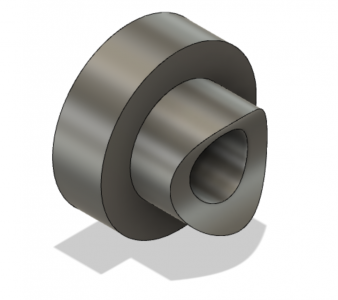- Joined
- Feb 28, 2019
- Messages
- 503
Of course efficiency depends on what matters to you most. I'm thinking time and minimize setup.
The major diameter is 1" and the length of the standoff is .58ish
I have a lathe (South Bend 9) and a drill mill (27" X). I'm thinking that I would start with 1" round stock, cut two lengths (about 15" long). Drill 12 holes in each for the saddles and spaced so I could then feed the stock through my lathe with a collet and turn the tee cylinder shape, parting off and alternating each.
However, there are a bunch of problems with that approach and it's not going to work!
#1 I can run 1" stock through my spindle
#2 It's going to fall apart when try to turn the small diameter and the tee is facing the wrong way.
So, second idea: Drill a bunch of holes in the round stock for the saddles, bandsaw apart so I end up with 24 pieces of stock with a saddle at each end.
Use my 3 jaw on the lathe - part is not that critical so 3 jaw centering error won't matter much.
This will work, but the fat base is only .31" thick so it will be fussy.
So maybe make some sort of custom fixture to go in a 3 or 4 jaw?
I look forward to suggestions!
Dave

The major diameter is 1" and the length of the standoff is .58ish
I have a lathe (South Bend 9) and a drill mill (27" X). I'm thinking that I would start with 1" round stock, cut two lengths (about 15" long). Drill 12 holes in each for the saddles and spaced so I could then feed the stock through my lathe with a collet and turn the tee cylinder shape, parting off and alternating each.
However, there are a bunch of problems with that approach and it's not going to work!
#1 I can run 1" stock through my spindle
#2 It's going to fall apart when try to turn the small diameter and the tee is facing the wrong way.
So, second idea: Drill a bunch of holes in the round stock for the saddles, bandsaw apart so I end up with 24 pieces of stock with a saddle at each end.
Use my 3 jaw on the lathe - part is not that critical so 3 jaw centering error won't matter much.
This will work, but the fat base is only .31" thick so it will be fussy.
So maybe make some sort of custom fixture to go in a 3 or 4 jaw?
I look forward to suggestions!
Dave



